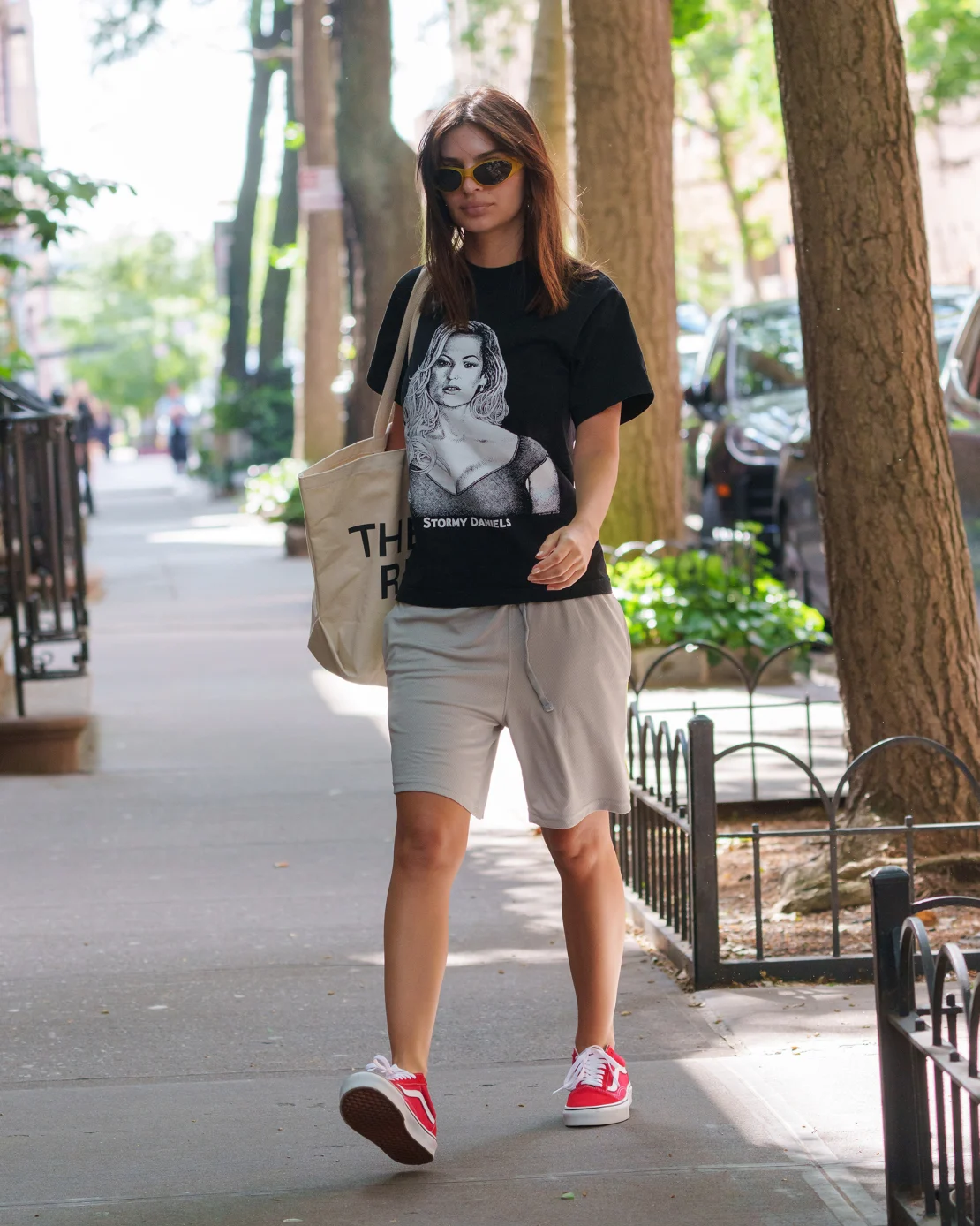Actions, or in this case clothes, sometimes speak louder than words. On the final day of Donald Trump’s hush money criminal trial — in which a jury found the former president guilty on all 34 counts of falsifying business records — Emily Ratajkowski was spotted wearing a not-so-subtle statement shirt.
Snapped while taking a stroll in New York City, the model, writer and actor was seen wearing a graphic T-shirt printed with Stormy Daniels face (Daniels is the adult film star and director who was allegedly paid $130,000 by Trump to keep quiet about an affair ahead of the 2016 election). The $95 shirt was designed by cartoonist Robert Crumb and, according to the brand Platform, directly supports the New York based domestic violence and sexual assault organization, “Safe Horizon,” by donating a portion of its sales.
Fashion has long been an important vehicle for political expression, particularly for those in the spotlight. In 1984, British designer Katherine Hammett became an early proponent of politically charged T-shirts, when she arrived to meet then British Prime Minister Margaret Thatcher in a top that read “58% don’t want Pershing” — a phrase lifted from an opinion poll on the undemocratic proliferation of American nuclear missiles across Europe. Hammett later told the Guardian in 2018 she hid the top tightly under her jacket, only exposing the words when she was in front of a wall of cameras. Thatcher bent down to read her shirt and “let out a squawk,” Hammett said.

Today, statements can range from the enigmatic to the undeniable. Ratajkowski herself is no stranger to the art of sartorial support, wearing a conspicuous Rage Against the Machine T-shirt in 2020 featuring a young Bernie Sanders. However in 2017, while delivering a televised speech on Brexit legislation, the late Queen Elizabeth II — well versed in the semiotics of clothing — wore a blue and yellow floral hat that many interpreted as subtle homage to the EU flag.
Similarly, at the Cannes Film Festival earlier this month, many online questioned whether Cate Blanchett’s Haider Ackermann dress was a tacit show of solidarity with Palestine amid the war in Gaza. The silk satin haute couture gown was half black and half blush-toned pink, with a striking emerald green lining only visible when she tossed her frock open. In an image captured by an elevated photographer, the pastel pink in Blanchett’s gown appeared almost white — a combination of colors, especially considering the red carpet of the Promenade de la Croisette, was enough for some to perceive as a nod to the de facto Palestinian flag. Neither Blanchett nor Ackermann (who made the dress in January 2023, some 9 months before the October 7 attacks) issued an official statement on the dress.

But in the digital age, explicit displays of support are sometimes at risk of being censored. On Wednesday, Vanity Fair France issued an apology after it was revealed that the magazine had edited out a Palestinian pin worn by actor Guy Pearce during a photoshoot. “As the Palestinian people are already suffering great trauma and loss due to the vengeful regime of Netanyahu it is most unfortunate that a reputable publication like VF attempts to eliminate support that I or anyone chooses to offer,” Pearce told CNN in an emailed statement. “Personally I think it is a disgrace.”
Hammett believes the quality of modern protest T-shirts have diminished to “watered-down messages,” and while there is no striking statistic or slogan on Ratajkowski’s top, there’s poetry in her choice of design. Daniels, whose claims were long underestimated because of her career as a sex worker, refused to be pressured by a powerful man into silence. Similarly, Ratajkowski has spoken at length in her 2021 book “My Body” about her experience enduring several instances of sexual assault.
“My position brought me in close proximity to wealth and power and brought me some autonomy, but it hasn’t resulted in true empowerment,” wrote Ratajkowski in the opening to her book. “That’s something I’ve gained only now, having written these essays and given voice to what I’ve thought and experienced.”





